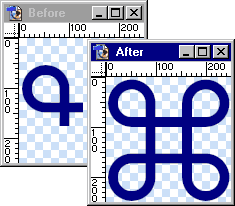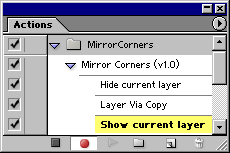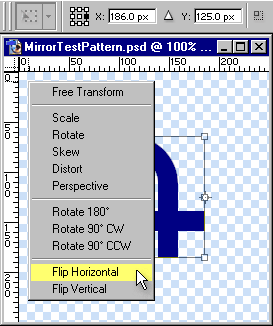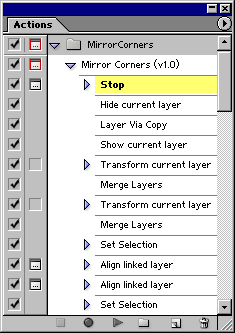 |
Select Software Tutorials |
 |
|

|
|
 |
|
 |
|
Welcome To ProDesignHost.com Photoshop Tutorials Area - Actions in Photoshop
Actions in Photoshop
Creating a More Complex Action
For this example, we will create an action that mirrors the active layer across
both the vertical and horizontal axes (on a separate layer to ensure that the
original layer remains unaltered) and then centers the results on the canvas.
This can be useful for creating symmetrical shapes, repeating patterns, and refrigerator
art ;-). To demonstrate what the action will do, see the figure below.
1. First, we'll need an image to practice on: to use while we record and test
our action. Create your own pattern.

2. Assuming the Actions palette is already visible, create a new set (  ).
Name the set "Mirror Corners". Add a new action to the set ( ).
Name the set "Mirror Corners". Add a new action to the set ( ).
Name the action "Mirror Corners (v1.0)", and assign a Function Key and Button
Mode color if you like. Finally, begin recording by pressing the Record button
( ).
Name the action "Mirror Corners (v1.0)", and assign a Function Key and Button
Mode color if you like. Finally, begin recording by pressing the Record button
(  ). ).
3. Because we are going to duplicate the current layer (to preserve the user's
original work), we will hide the layer so that it does not obstruct the view
of the final results. Click the Visibility icon (  )
associate with the current layer. Notice that a command called "Hide current
layer" has been added to the action. )
associate with the current layer. Notice that a command called "Hide current
layer" has been added to the action.
4. Next, duplicate the current layer by pressing Ctrl+J (Layer > New > Layer
via Copy). Turn on the new, duplicated layer by clicking on its Visibility icon.
Both commands should appear in the action.

5. In this step we will use the Edit > Transform command to flip a horizontal
duplicate of our current layer.
Note: Holding down the Alt key while choosing Edit > Transform
performs a transform on a duplicate of the original selection. Using this technique
allows you to get two steps for the price of one!
Press Ctrl+Alt+T. In the Options palette, set the Reference Point location to
the right side (  );
then right-click in the document window and choose Flip Horizontal from the context
menu. Press Enter to accept the transformation. );
then right-click in the document window and choose Flip Horizontal from the context
menu. Press Enter to accept the transformation.

6. Merge the two halves / layers together by pressing Ctrl+E (Layer > Merge Down).
7. Now let's flip the current layer vertically - similar to what we did in step
5. Press Ctrl+Alt+T. In the Options palette, set the Reference Point location
to the bottom (  );
then right-click in the document window and choose Flip Vertical. Press Enter
to accept the transformation. );
then right-click in the document window and choose Flip Vertical. Press Enter
to accept the transformation.
8. Again, merge the two halves together by pressing Ctrl+E.
9. To center the pattern we'll use the Layer > Align Linked To Selection commands.
Note: Unfortunately, you cannot use the Alignment buttons in
the Options palette because their functions will not get recorded.
Select the entire canvas by pressing Ctrl+A (Select > All). From the menus, choose
Layer > Align To Selection > Vertical Centers followed by Layer > Align To Selection > Horizontal
Centers. Drop the selection by pressing Ctrl+D (Select > Deselect).
10. Finally, stop recording by pressing the Stop button (  ).
As a final touch, let's add a Stop message to let other users know what this
action does. Choose Insert Stop from the Actions palette menu ( ).
As a final touch, let's add a Stop message to let other users know what this
action does. Choose Insert Stop from the Actions palette menu (  ).
Enter a brief description about what the action does and then check the Continue
button. ).
Enter a brief description about what the action does and then check the Continue
button.
Because we want the message to be displayed at the beginning of the action, drag
the newly added Stop command above the "Hide current layer" command (in the Actions
palette) - so that it appears as first step in the action.
Note: If you want the message to be present in the action, but
not displayed each time the action is played, simply uncheck the Include checkbox
(  )
for the Stop. )
for the Stop.

Now try your new action on different patterns and canvas sizes to make sure it
works properly. Once you are happy with the action, save it using the Save Actions
command in the Actions palette menu.
Tips for Editing Actions
Here are a few tips that will make it easier to edit your actions:
- To begin playback from a specific step of an action, simply choose the
desired step and press the Play button at the bottom of the Actions palette.
- Drag and drop steps to reorder them. This also works for actions and sets.
- Alt-drag a step to duplicate it. This also works for actions and sets.
- Double-click an action step to rerecord its associated values. Alternatively,
you may choose Record Again from the Actions palette menu.
- Ctrl-click the button to play only the selected step. This is useful for
debugging an action.
- Select non-contiguous action steps using the Shift key. Use the Ctrl key
to range select contiguous action steps. You may then delete, duplicate or
even play the selected steps! However, this only works within the current
action.
- Alt-click the Delete button (on the Actions palette) to delete the selected
item without confirmation. This is equivalent to dragging the desired item
onto the Delete button.
- Even though operations performed in the Actions palette may not be undone
using the Edit > Undo command or the History, you can undo / redo the last
operation (and only the last operation) by pressing Ctrl+Z.
- Hold both the Ctrl and Alt keys when choosing Save Actions (from the Actions
palette menu) to save all actions as a text file. This is very useful for
reviewing or printing the contents of an action: however, the text file cannot
be reloaded into Photoshop.
- Alt-click on an action (not a step) triangle (
 )
to expand / collapse all steps within the action. )
to expand / collapse all steps within the action.
- Alt-click on a set triangle (
 )
to expand / collapse all steps within the set. )
to expand / collapse all steps within the set.
- To include a path within an action, first create the path (before recording
the action); then, begin recording, activate/select the path select and choose
Insert Path from the Actions palette menu.
Note: Set your ruler units to percentage before using the
Insert Path command to ensure that the path is scaled and positioned relative
to the canvas size. Otherwise, the path may appear too large, or completely
outside the canvas boundaries.
- Create a snapshot (via the New Snapshot button in the History palette)
before running an action. That way, if you do not like the results, you can
revert the image to its original state without having to undo every step
performed by the action.
Note: ImageReady treats actions as single steps in its History
palette so you can undo actions in one step.
Tips and Guidelines for Creating Actions
Keep things generic
- Try to build your actions using commands that do not use specific layer
names (unless the layers are created by the action itself). For example,
instead of choosing the previous or next layer by name, use the backward
layer and forward layer keyboard shortcuts: Alt+[ and Alt+ ], respectively.
(Add the Shift key to select the bottom-most or top-most layer.)
- Use Percent as your units of measurement (where applicable) to avoid situations
where specific transformations may be beyond the capabilities of another
canvas size.
- Perform all your operations within a single canvas (i.e. the current canvas).
Photoshop does not refer to documents by name, but as "next" or "previous" documents:
this can cause problems if the number or order of documents changes.
Reduce, reuse and recycle
- Optimize your action wherever possible. The fewer steps, the faster the
action will play and the easier it will be to debug when / if something goes
wrong. For example, let's say you have an action with four steps that duplicate
a layer, name it, and then change its blending mode and opacity. All of these
operations could, instead, have been accomplished in one step using the Layer > New > Layer
via Copy dialog box.
- If several steps need to be repeated, record them as a separate action;
then have the first action refer to the second action as required (like an
action subroutine).
- Examine other people's actions to learn new (or better) ways to accomplish
certain techniques.
Consideration for other users
- Include instructions (by using Stops) that advise the user what the action
does and what is expected. If your action requires additional plug-ins, give
the name and source of the plug-ins. You might also want to include your
name and email address in case the user has problems or suggestions.
- Include a version number to distinguish different (updated) copies of the
action.
- Test your action in several different situations to insure trouble-free
operation.
- Preserve original layers whenever possible. If this is not possible, at
least have the action duplicate the document as a first step.
Managing your actions
- Organize your actions by creating subfolders within the default Photoshop
Actions folder (C:\Program Files\Adobe\Photoshop 6.0\Presets\Photoshop Actions\
- assuming a default install on a PC). Photoshop will still find these actions
and even make them available from the Action palette menu.
- Prefix actions subfolders (or even individual actions) with a tilde (~)
to disable them. Photoshop will ignore any filenames beginning with a tilde.
- To apply an action (or a series of actions) to a series of images, use
the File > Automate > Batch command.
- Use the File > Automate > Create Droplet command to save an action as a
droplet. A droplet is a small executable file that will automatically launch
Photoshop and apply the designated action to any images that you drop onto
it.
For a great source of free actions, visit the Adobe
Action Xchange. As a member of the Action Xchange, you can even upload your
actions for other users. Membership is free.
I hope that you found this tutorial comprehensive and easy to follow (but most
of all that you learned something along the way ;-).
|
|

